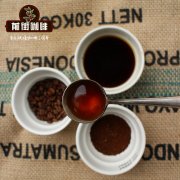Tibica coffee, one of the oldest varieties of Tibica coffee beans, is characterized by sour, warm and supple aroma.

Professional coffee knowledge exchange more coffee bean information please follow the coffee workshop (Wechat official account cafe_style)
Introduction to the varieties of Qianjie-tin card
Typica is also known as Tibika, Tibika and Tippika due to the differences between English and Chinese translation. For the old variety of small-grain coffee, its resistance to diseases and insect pests is not strong, the yield is low, and it is difficult to cultivate, so the price is much higher than that of ordinary small-grain coffee. It is native to Ethiopia and southeastern Sudan and is the most widely cultivated variety of coffee in the Western Hemisphere. The plant is strong, but it is not resistant to light. The top leaf of the iron pickup is red copper, which is called red top coffee.
The Ironpika tree has fine branches and large distance between branches, so when it bears fruit, the coffee fruit is strung together like a bead chain, and there is a clear gap between each bead; the leaf shape is small and the leaf fleshy is thin.
Typica iron pickup, which is typical of Arabica species, is also the first variety to be transplanted from Yemen to India, Indonesia and Central and South America.
The ancient iron pickup is characterized by larger beans and longer pointed beans, but many different forms have been derived from the transplantation into the new world, as well as oval and smaller iron pickups.
The taste of iron pickup coffee beans is very balanced, mild and supple is its biggest feature, the sour smell of iron pickup, not tricky, not changeable, suitable for those who are afraid of acid, but iron pickup planting altitude is less than 1000 meters or the temperature is too high, easy to have sawdust smell.
This coffee variety is considered to be the prototype of all variants or genetic screening. The Netherlands was the first country to spread coffee to all parts of the world for commercial cultivation. Iron pickup was the kind of coffee at that time. The fruit of the iron pickup was usually red and the flavor in the cup was outstanding, but its fruit yield was less than that of other varieties. Iron pickups are still grown in many coffee-producing countries around the world, so it has different names in different places, such as Criollo, Sumatra and Arabigo.
Knowledge: iron pickup and bourbon, the two ancient varieties, have multiplied for three hundred years in different soil and water in the new world, creating thousands of varieties and hybrids.
In short: Qianjie is a coffee research hall, happy to share the knowledge about coffee with you, we share unreservedly just to make more friends fall in love with coffee, and there will be three low-discount coffee activities every month. The reason is that Qianjie wants to make more friends drink the best coffee at the lowest price, which has been Qianjie's tenet for 6 years!
END
Important Notice :
前街咖啡 FrontStreet Coffee has moved to new addredd:
FrontStreet Coffee Address: 315,Donghua East Road,GuangZhou
Tel:020 38364473
- Prev

Katim Coffee Bean shape how to distinguish the characteristics of Katim coffee defective products of Luo bean gene?
Professional coffee knowledge exchange more coffee bean information please follow the coffee workshop (Wechat official account cafe_style) front street-Yunnan small Coffee introduction Katim (catimor) is not pure Arabica blood, it is a hybrid of Timor and bourbon. Compared with the old variety, it lacks rich aroma and taste, and has a relatively shallow and fishy taste.
- Next

Typica coffee beans belong to the early days of Tibica and bourbon coffee.
Professional coffee knowledge exchange more coffee bean information please follow the coffee workshop (Wechat official account cafe_style) front street-tin pickup, bourbon variety introduction in Arabica's recognized hometown, Ethiopia, there are more than 2000 known bean species, in the wild coffee forests, there are more unknown waiting to be explored. Most of them are collectively referred to as native species, such as we are familiar with
Related
- Beginners will see the "Coffee pull flower" guide!
- What is the difference between ice blog purified milk and ordinary milk coffee?
- Why is the Philippines the largest producer of crops in Liberia?
- For coffee extraction, should the fine powder be retained?
- How does extracted espresso fill pressed powder? How much strength does it take to press the powder?
- How to make jasmine cold extract coffee? Is the jasmine + latte good?
- Will this little toy really make the coffee taste better? How does Lily Drip affect coffee extraction?
- Will the action of slapping the filter cup also affect coffee extraction?
- What's the difference between powder-to-water ratio and powder-to-liquid ratio?
- What is the Ethiopian local species? What does it have to do with Heirloom native species?

